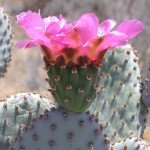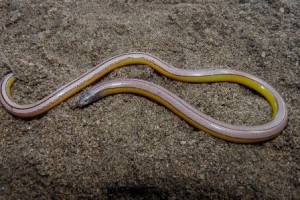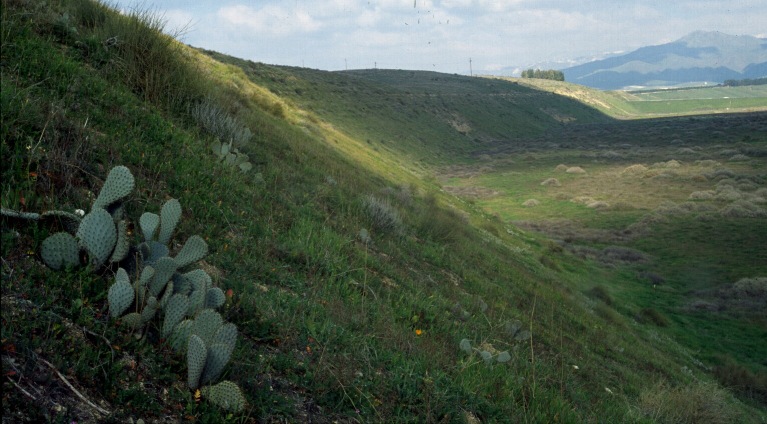
Area: 270 acres
Location: 15 miles east of Bakersfield, Kern County, California.
Date Acquired: 1997
Acquisition Type: The Center for Natural Lands Management owns Sand Ridge. We protect and manage species and habitats on the preserve in perpetuity.
Key Habitats: Desert Scrub
Species of Special Interest to CNLM: Bakersfield cactus (Opuntia treleasei (=Opuntia basilaris var. treleasei)), Bakersfield legless lizard (Anniella grinnelli), giant flower-loving fly (Rhaphiomidas trochilus), and Sand Ridge Jerusalem cricket (Stenopelmatus sp. nov.).
The Preserve is currently closed to public access.
Introduction
 Interest in preserving the Sand Ridge Preserve, with its wildflower displays and robust population of Bakersfield cacti (Opuntia treleasei) began in the late 1950s. Through donations, The Nature Conservancy purchased the original parcel in 1965, and subsequent parcels in 1984 and 1990. In 1997, the Preserve was transferred to the Center for Natural Lands Management. In 1984, the U.S. Department of Interior gave Sand Ridge the designation of National Natural Landmark in recognition of its unique botanical values.
Interest in preserving the Sand Ridge Preserve, with its wildflower displays and robust population of Bakersfield cacti (Opuntia treleasei) began in the late 1950s. Through donations, The Nature Conservancy purchased the original parcel in 1965, and subsequent parcels in 1984 and 1990. In 1997, the Preserve was transferred to the Center for Natural Lands Management. In 1984, the U.S. Department of Interior gave Sand Ridge the designation of National Natural Landmark in recognition of its unique botanical values.
Conservation Significance
The Preserve encompasses a portion of a narrow sandy ridge and part of the floodplain of Caliente Creek, an intermittent stream with headwaters in the Sierra Nevada and Piute Mountains. The ridge portion of the Preserve rises approximately 120-180 feet above the Caliente Creek floodplain and is composed of alluvial and wind-deposited sand. This sand system is highly isolated from similar habitat and hosts several rare and endangered species. The federally endangered Bakersfield cactus once carpeted the southern San Joaquin Valley and adjacent foothills. Today there are only four locations—Sand Ridge being one—with significant populations of this species. The Sand Ridge Jerusalem cricket (Stenopelmatus sp. nov.) and the giant flower-loving fly (Rhaphiomidas trochilus) are currently found only at Sand Ridge.
An example of how new species can still be discovered—even in a well-studied place such as California—is the Anniella grinnelli, a new species of legless lizard discovered recently on the Preserve. Descriptions of the Bakersfield legless lizard (A. grinnelli), along with three other new species of legless lizards, were published in 2013. According to the herpetologists who made this discovery, Dr. Ted Papenfuss and Dr. James Parham, the coincident discovery of this and the other species marked the first time that so many new species of lizards have been described from California at one time, making this an unprecedented herpetological discovery for the state. The new species at Sand Ridge was named after Joseph Grinnell (1877–1939), the first director of the Museum of Vertebrate Zoology at the University of California at Berkeley. The Sand Ridge Preserve is the type locality for this new species.
The plant communities at Sand Ridge Preserve are a relatively unique assemblage of San Joaquin Valley and Mojave Desert species. Dominant shrubs include Mormon tea (Ephedra californica), brittlebush (Encelia actoni), bladderpod (Isomeris arborea), and cheesebush (Hymenoclea salsola). Bakersfield cacti are most abundant on top of the ridge and along the eastern slope. A variety of wildflowers carpet the landscape in spring, including Coulter’s jewelflower (Caulanthus coulteri), lupines (Lupinus spp.), poppies (Eschscholzia spp.), Mojave sand verbena (Abronia pogonantha), chia sage (Salvia columbariae), sun cups (Camissonia spp.), and desert dandelion (Malacothrix californica). Nonnative grasses, such as ripgut brome (Bromus diandrus) and wild oats (Avena fatua), dominate much of the herbaceous vegetation during wet periods. Scale-broom (Lepidospartum squamatum), mule fat (Baccharis salicifolia), and cottonwood trees (Populus fremontii) are found along the floodplain of Caliente Creek. Most of the surrounding land is used for farmland, but California Department of Fish and Wildlife (CDFW) owns about 200 acres along the southern border.
Our Work
The overall management objective at the Sand Ridge Preserve is to maintain a functioning ecosystem that supports Bakersfield cactus and other rare species. The primary threats to the ecosystem are a result of ripgut brome (Bromus diandrus), Saharan mustard (Brassica tournefortii), and other nonnative plants that compete with the native species for space, water, and nutrients. Illegal activities such as off-road vehicle use, vandalism and dumping also occur at times. CNLM is attempting to control these threats, but efforts are unfortunately hampered by a lack of funding for this Preserve.
Public Access
The preserve is open most of the year to the public with permission from the preserve manager. A 1.2 mile hiking trail is found along the top of Sand Ridge.
Contact
For information about Sand Ridge or the Center for Natural Land Management, please contact Greg Warrick, Preserve Manager at gwarrick@cnlm.org or 760.731.7790 extension 202



